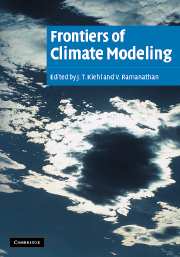Book contents
- Frontmatter
- Contents
- Preface
- List of Contributors
- Acknowledgments
- 1 Overview of climate modeling
- 2 Climate-change modeling: a brief history of the theory and recent twenty-first-century ensemble simulations
- 3 Energy-balance climate models
- 4 Intrinsic climatic variability: an essay on modes and mechanisms of oceanic and atmospheric fluid dynamics
- 5 The radiative forcing due to clouds and water vapor
- 6 A model study of the effect of Pinatubo volcanic aerosols on stratospheric temperatures
- 7 Unresolved issues in atmospheric solar absorption
- 8 Cloud feedbacks
- 9 Water-vapor feedback
- 10 Water-vapor observations
- 11 New frontiers in remote sensing of aerosols and their radiative forcing of climate
- 12 Cloud–climate feedback: lessons learned from two El Niño events
- 13 Runaway greenhouses and runaway glaciations: how stable is Earth's climate?
- Glossary
- Plate section
6 - A model study of the effect of Pinatubo volcanic aerosols on stratospheric temperatures
Published online by Cambridge University Press: 12 August 2009
- Frontmatter
- Contents
- Preface
- List of Contributors
- Acknowledgments
- 1 Overview of climate modeling
- 2 Climate-change modeling: a brief history of the theory and recent twenty-first-century ensemble simulations
- 3 Energy-balance climate models
- 4 Intrinsic climatic variability: an essay on modes and mechanisms of oceanic and atmospheric fluid dynamics
- 5 The radiative forcing due to clouds and water vapor
- 6 A model study of the effect of Pinatubo volcanic aerosols on stratospheric temperatures
- 7 Unresolved issues in atmospheric solar absorption
- 8 Cloud feedbacks
- 9 Water-vapor feedback
- 10 Water-vapor observations
- 11 New frontiers in remote sensing of aerosols and their radiative forcing of climate
- 12 Cloud–climate feedback: lessons learned from two El Niño events
- 13 Runaway greenhouses and runaway glaciations: how stable is Earth's climate?
- Glossary
- Plate section
Summary
Introduction
As discussed in Chapters 1 and 4, radiation forcing from stratospheric aerosols contributes to the variability of the climatic system. This chapter provides a detailed analysis of how these aerosols affect Earth's climate system. Stratospheric aerosols, in the aftermath of intense volcanic eruptions, can perturb substantially the climate of the stratosphere and surface–troposphere system (IPCC, 1995). Typically, the particulates appearing initially are comprised of silicates (e.g., ash). These are large (diameter greater than a few microns) and tend to fall off rapidly (within a few months) (Robock et al., 1995). The conversion of the sulfur-containing gases injected into the stratosphere to sulfate aerosols occurs in a few weeks to months. This results in a loading of the stratosphere with submicron sulfate aerosols having a residence time of one to two years. The radiative effects depend on the type, size, and shape of the particulates. While in the first several weeks, the radiative effects may be dominated by the ash particles, over the longer term (after a few months and up to ∼ two years) and of considerable relevance to climate, the sulfate aerosols dominate the effects. We focus on the effects due to sulfate aerosols in this study.
Sulfate aerosols possess absorption bands in both the solar and longwave spectra, and have significant scattering ability in the solar spectrum.
- Type
- Chapter
- Information
- Frontiers of Climate Modeling , pp. 152 - 178Publisher: Cambridge University PressPrint publication year: 2006

